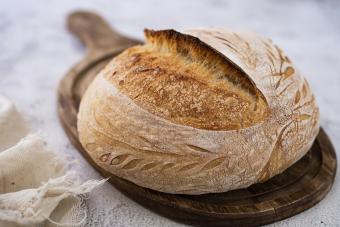
Exotic mushrooms add a distinct flavor to your cooking, but unless you are a mushroom expert, known as a mycophagist, you are safer getting your mushrooms from the store. Some types of poisonous mushrooms look just like some types of edible mushrooms. While wild mushrooms may look wild and taste wild, it is better to play it safe when choosing your mushrooms.
Button Mushrooms
Button mushrooms are the most common type of mushroom available. They are available in virtually every grocery store, and are used in recipes like pasta, pizza, stroganoff, and many others. They are safe to eat because they are cultivated.

Cultivated Exotic Mushrooms
Cultivated exotic mushrooms are grown in a controlled environment and are very safe to eat. They are sometimes more expensive than button mushrooms but, as an occasional treat, are worth the extra money and effort to find them.
Shiitake Mushrooms
Shiitake mushrooms are also known as Black Forest mushrooms or Golden Oak mushrooms. They are mostly cultivated in Japan, China, and South Korea, but are also available from Australia and North America.
When fresh, the mushrooms color ranges from light golden brown to dark brown. They have a wide cap with a firm fleshy texture, but the stems are very tough and are either chopped very fine for sautéing or saved for making stock.
These mushrooms are also available in a dried form. The dried shiitake can be stored for a long time and can be revived just by soaking in water. The water that the dried shiitakes have been reconstituted in can then be used to make a delicious mushroom sauce. As far as exotic mushrooms go, the dried shiitake is a good way to add great flavor to your recipes while saving money.

Oyster Mushroom
The oyster mushroom, also known as Pleurotte, gets its name from the way it looks and not its flavor.
Oyster mushrooms are light tan or cream colored with a large, fan-like cap and a short stem. These tender mushrooms have a delicate flavor, so they are best prepared simply so the flavor isn't overpowered.

Enoki Mushrooms
These mushrooms are also known as Enokitake or Enokidake. They have a tiny white cap on a long slender stem. They grow in bunches from a single base, so you will be selecting clusters rather than single mushrooms. You just trim off the base and give the Enoki a quick rinse to prepare them. Enoki have a crisp texture and a fruity, sweet flavor and are very good raw in a salad. If you are using them in a cooked dish, add them last to keep the texture and flavor.

Cremini Mushrooms
Cremini mushrooms are also known as baby bellas, because they are just a small version of a portobello mushroom. They have a brown color and a deep, earthy flavor. Cremini are the slightly more mature variation of the common button mushroom. Use these wherever you would use button mushrooms but expect a deeper, richer flavor.

Portobello Mushrooms
The most mature version of the Cremini mushroom, portobello mushrooms can grow up to 6-inches wide, are great for grilling or stuffing, and can be used as a substitute for meat in some recipes.

Wild Mushrooms
Wild mushrooms bring more flavor to every recipes, but only use wild mushrooms that you find at the market. Eating wild mushrooms that you find in the actual wild can be dangerous.
These four wild mushrooms are available fresh as well as dried. You may want to consider the dried variation because they keep longer, have a more intense flavor, and the water that you use to restore them can be used to make a mushroom sauce.
Morel Mushrooms
Morels can be found in several varieties including black, golden, and white. Morels look like a conical sponge and are completely hollow inside. They are available fresh in the spring or dried all year long. Use them in butter or cream-based sauces.

Bolete Mushrooms
Also known as Cep, or Porchino, or porcini (Bolete mushrooms from Italy) this brown capped mushroom has a light colored bulbous stem and a cream colored flesh. The smooth meaty texture of this mushroom has a rich earthy flavor and is best sautéed with butter and garlic. Bolete are usually available in late summer and early fall.

Chanterelle Mushrooms
Chanterelle are also known as Girolle. They are yellow to orange in color and look like an inverted umbrella. This mushroom has ridges rather than gills. Chanterelle have a rich woodsy flavor and aroma and are best when sautéed with butter and a little garlic. Chanterelle are available during the summer and fall.

Black Trumpet
These mushrooms are related to Chanterelles, but are black in color with much thinner flesh.

Truffles
Truffles are very rare and only found in southern France and Northern Italy. Black truffles can cost as much as $130 to $390 dollars per pound while white truffles can cost as much as $1350 to $2700 per pound.
Black truffles grow only on the roots of oak trees while white truffles can be found growing on the roots of oak, hazel, poplar, and beech trees. Specially trained hogs and dogs are used to find these delightful fungi.
In general, truffles are shaved onto a meal just before serving. A more cost effective way of getting the rich, earthy flavor of these mushrooms into your food is to look for truffle oil, which is usually olive or vegetable oil infused with truffles.

A Flavorful Addition
Mushrooms are a flavorful addition to many dishes, such as omelets and pastas. With an earthy flavor that can range from delicate to powerful and savory, you're sure to find a mushroom that suits your tastes.







